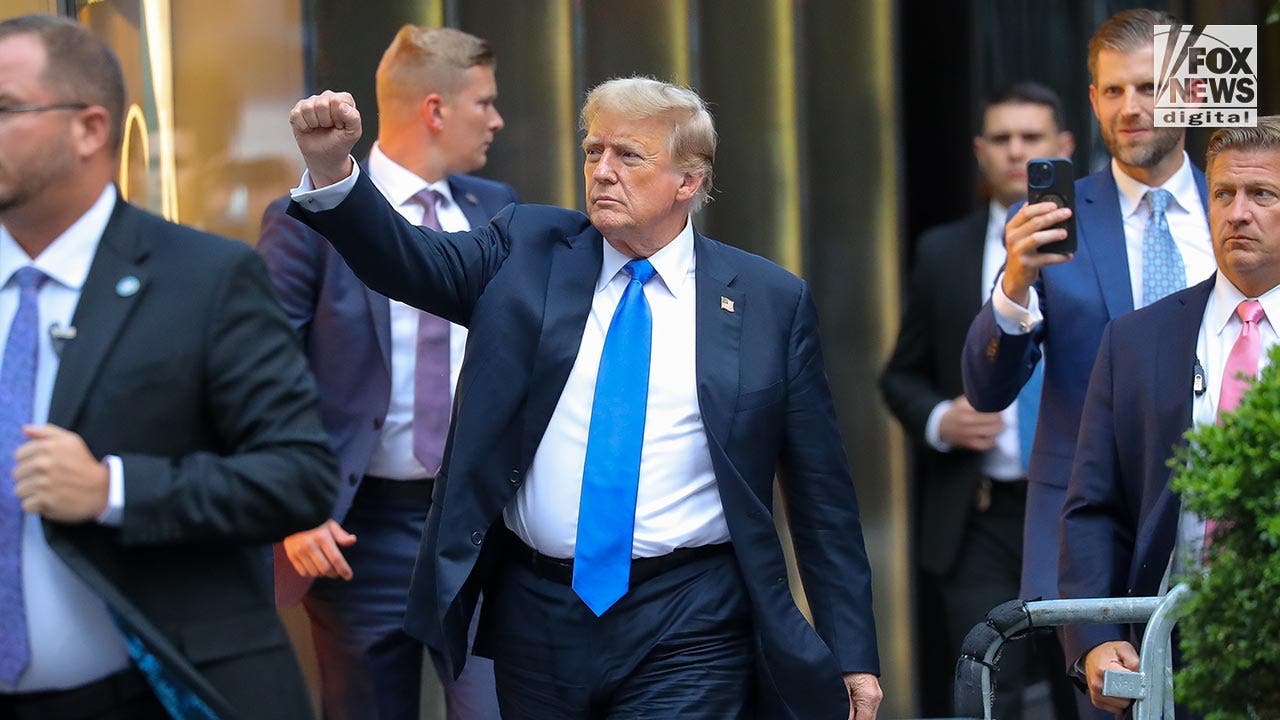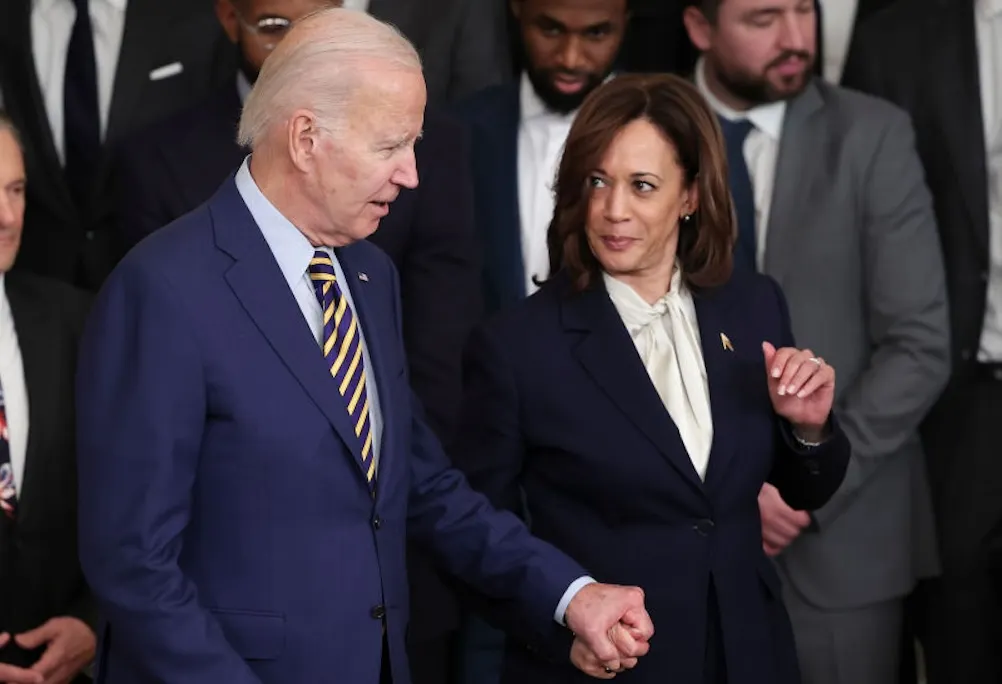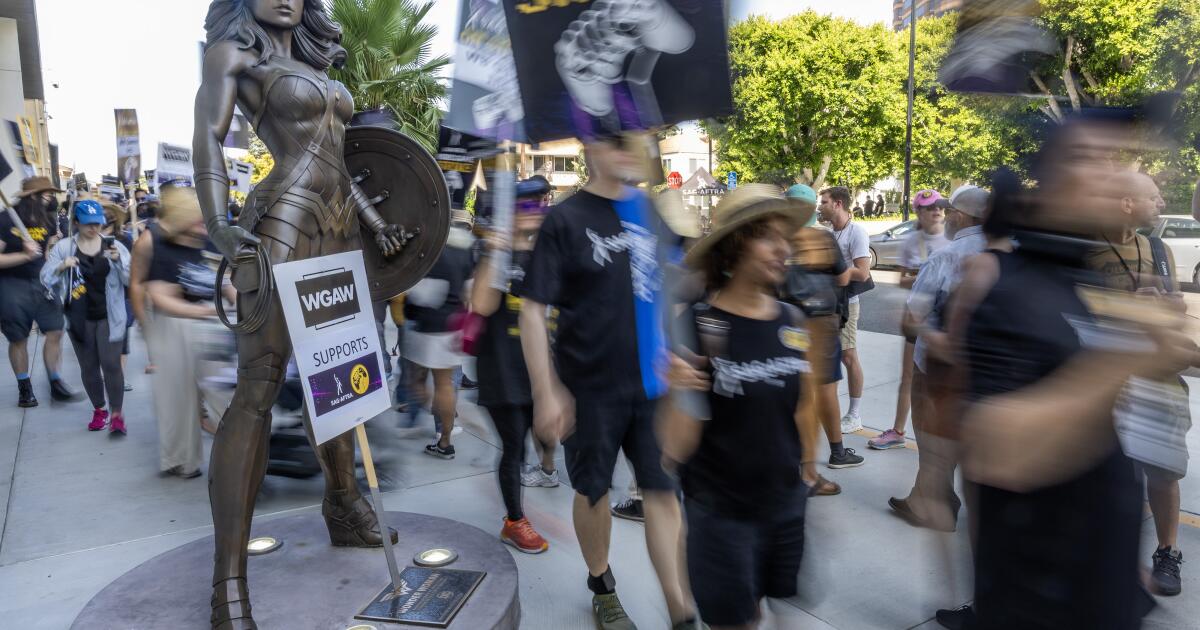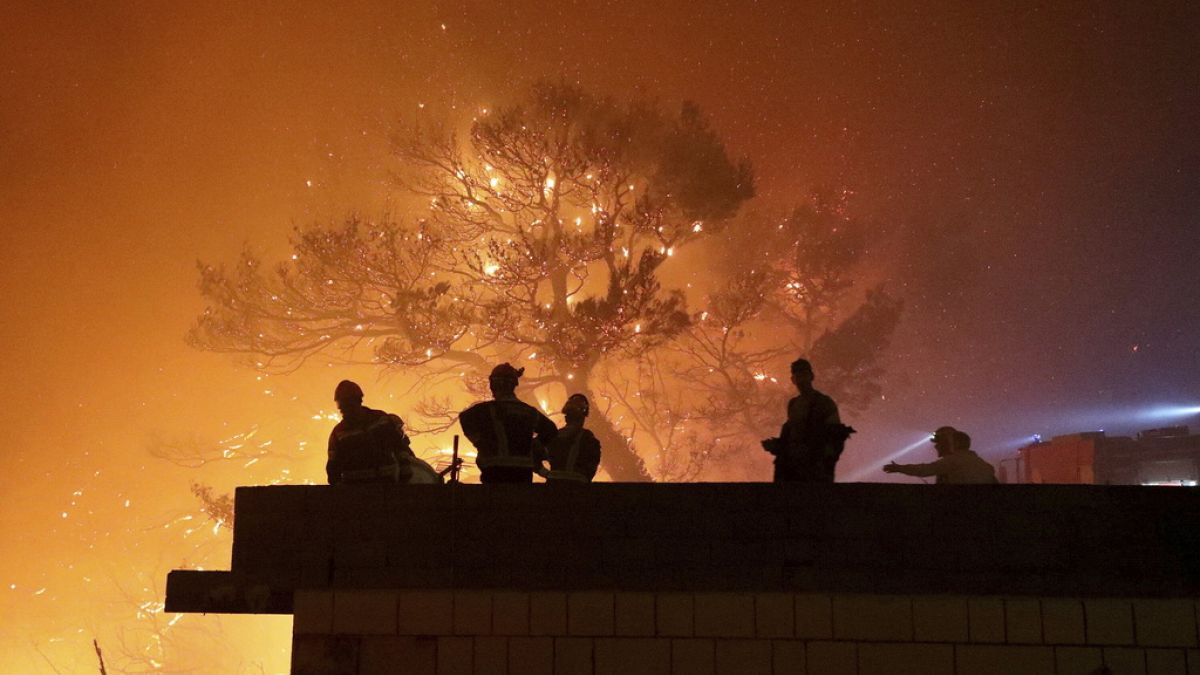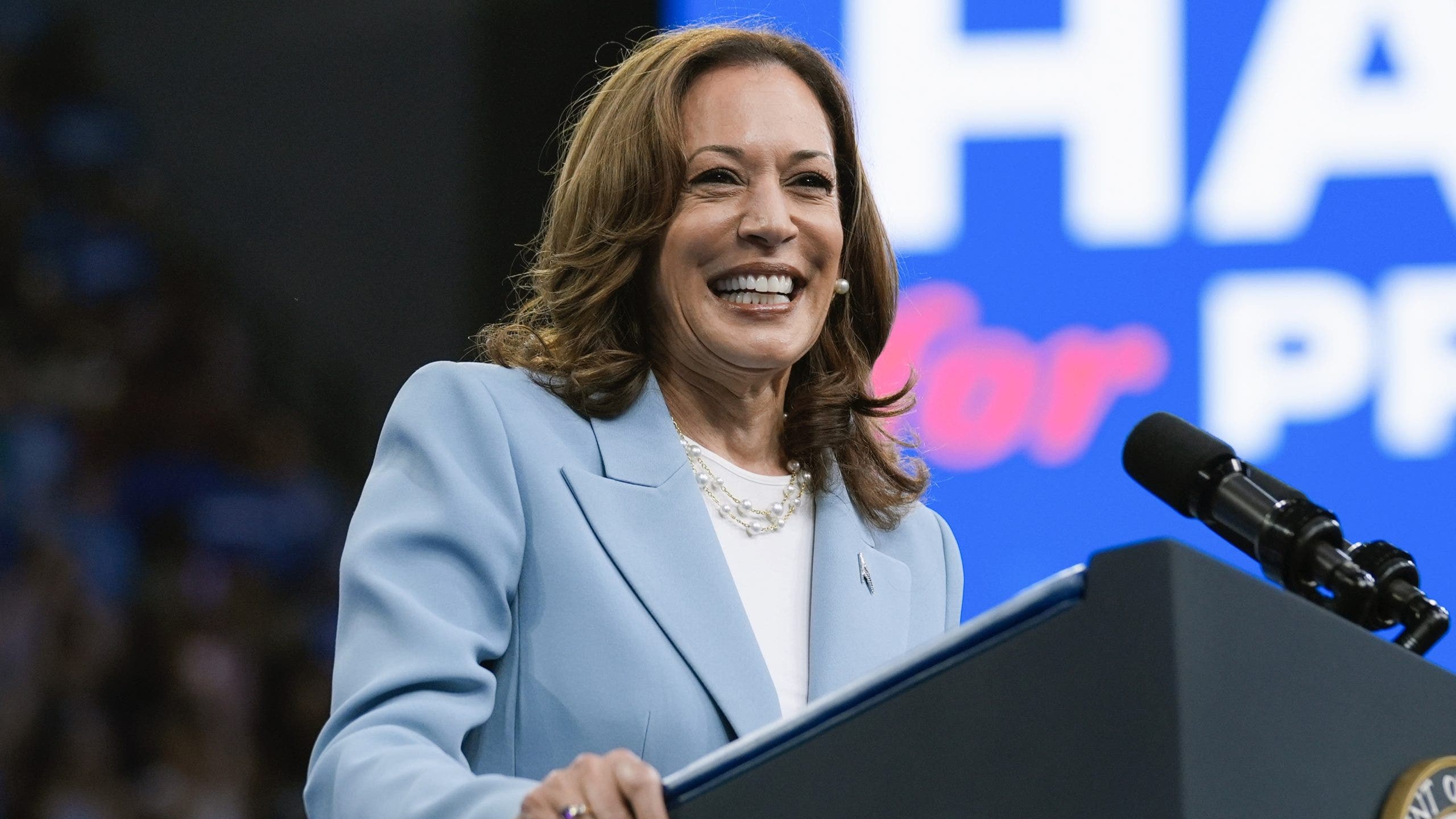Entertainment
This country banned TikTok. What became of its influencers?
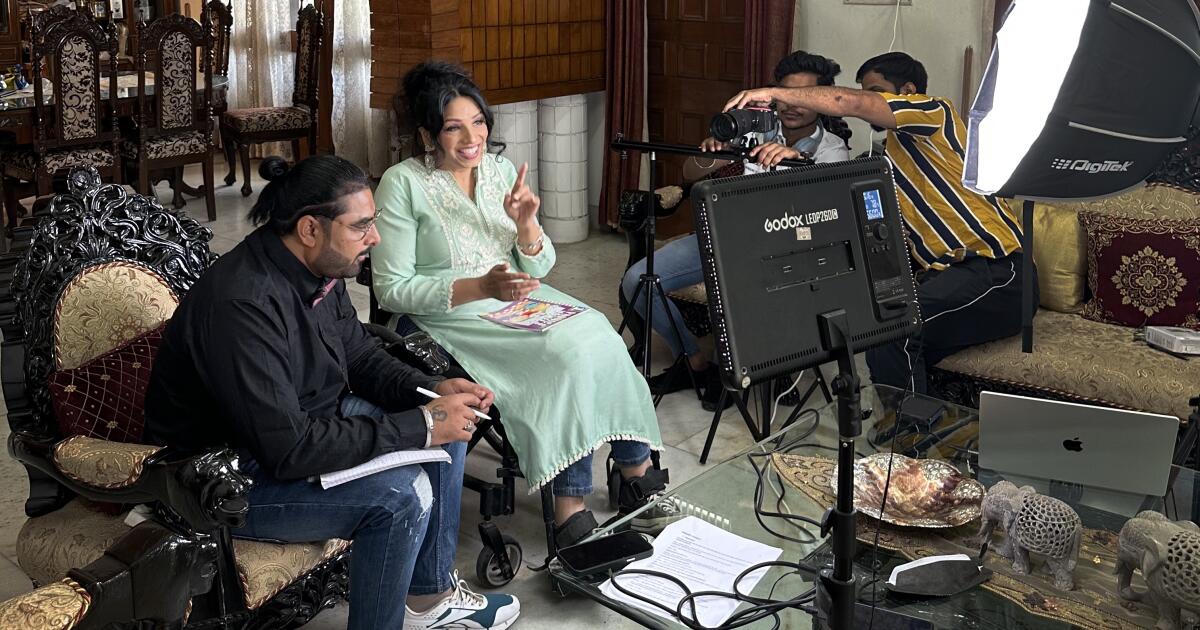
Is there life after TikTok?
The question is front of mind for U.S. influencers and many small businesses as lawmakers threaten to ban the Chinese-owned social media app that’s become a cornerstone of internet culture and e-commerce.
For an answer, they might turn to India, which has been surviving without TikTok since June 2020.
That month, after 20 of its soldiers were killed in a border clash with China, the Indian government gave TikTok users a day to post tearful goodbyes and steer followers to other social media accounts. Then the app went dark.
People light candles in Hyderabad on June 17, 2020, in tribute to the 20 soldiers killed during a border clash between Indian and Chinese forces in the Ladakh region.
(Mahesh Kumar A / Associated Press)
“When it got banned, I had nothing,” recalled Gaurav Jain, who was one of the country’s more than 200 million TikTok users.
He was 25 and had just notched his millionth follower making self-help videos about mental health, men’s style and relationships.
Four years later, Jain runs his own social media marketing agency in Delhi, managing Indian content creators who pivoted to other platforms or joined the influencer world more recently. He had tried to make the transition himself but found starting from scratch demoralizing.
“The counter became zero for everyone,” he said. “That gave rise to a lot of new creators.”
The results for former TikTok stars have been mixed.
Gautan Madhavan, founder of Mad Influence, a marketing agency that managed more than 300 content creators before the TikTok ban, said that about a third of them were able to recapture their reach on Instagram Reels or YouTube Shorts within three months and that many are still playing catch-up.
Those short-video platforms launched shortly after the TikTok ban. Users who found success got in early and posted as often as 10 times a day, according to Saptarshi Ray, a consultant for influencers trying to grow their followings.
“Most of them were just trying everything,” Ray said. “Those were the creators that really flourished.”
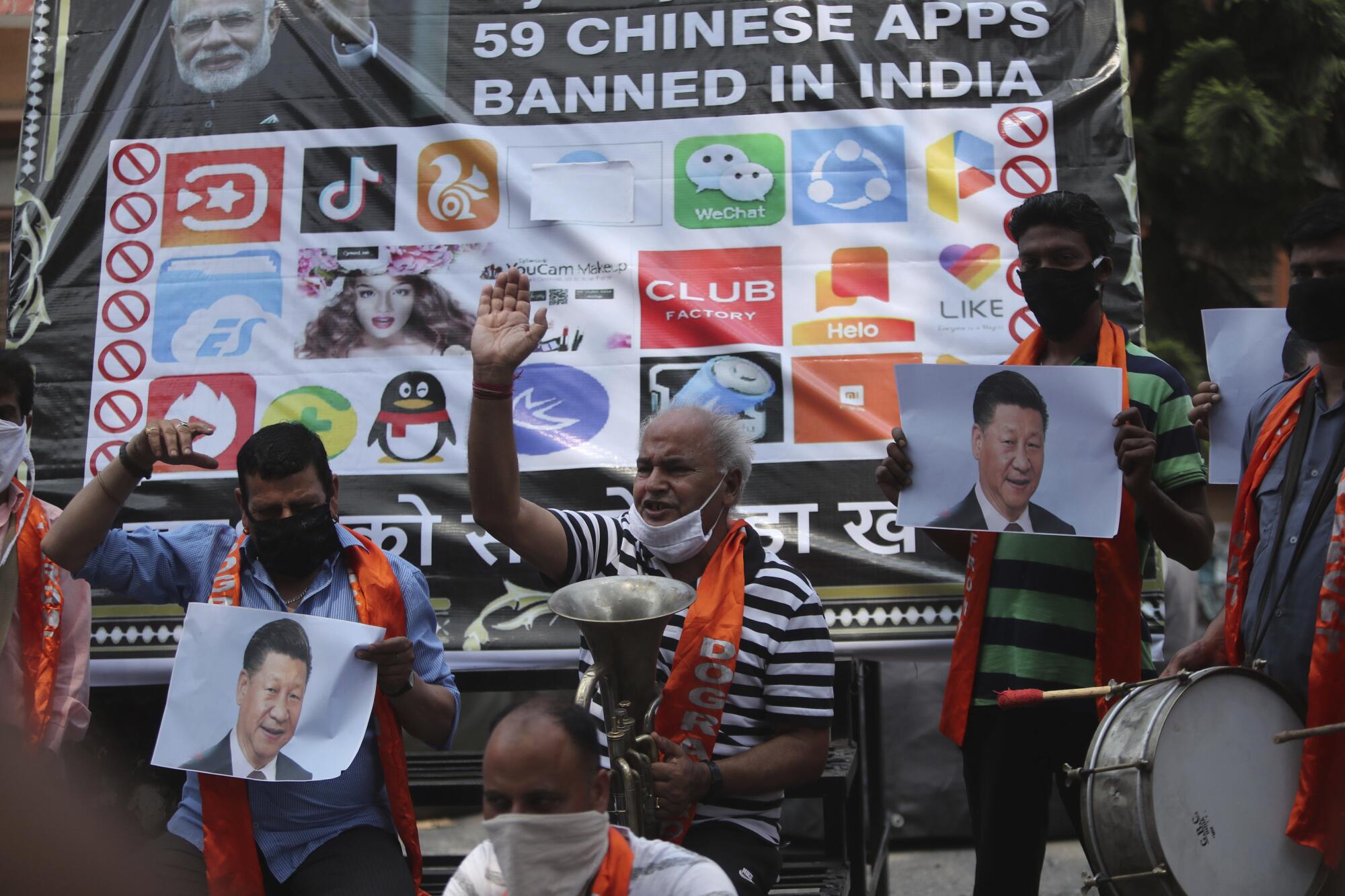
Activists shout slogans against Chinese President Xi Jinping next to a banner showing the logos of TikTok and other Chinese apps banned in India during a protest in Jammu, India, on July 1, 2020.
(Channi Anand / Associated Press)
India was TikTok’s fastest growing user base before the ban, which cut off a vital source of income for creators there.
The stakes are even higher in the United States, where the app has more than 170 million users, including 7 million businesses that TikTok says generated $14.7 billion in revenue last year from marketing on the platform. The Pew Research Center found that a third of Americans used TikTok last year, up from a fifth in 2021.
In April, President Biden signed a bill to ban the app by January 2025, unless Chinese parent company ByteDance Ltd. agrees to sells the app to somebody from a country that is not considered a foreign adversary.
The threat comes as suspicion between the U.S. and China has escalated, reviving concerns that TikTok could share sensitive data with the Chinese government.
The proposed ban still faces high hurdles. Both TikTok and a group of U.S. content creators separately filed lawsuits, arguing that blocking the app would be an unconstitutional assault on free speech. The Trump administration had also tried to ban TikTok but gave up after being challenged by federal courts.
TikTok has sought to assure the U.S. government that user data is protected on U.S. servers. And though its parent company is based in Beijing, TikTok moved operations to Singapore under a Singaporean chief executive.
The U.S. — along with Britain and Australia — has already prohibited the use of TikTok on government devices. But digital marketing experts said many U.S. users are still not seriously considering the possibility of a ban.
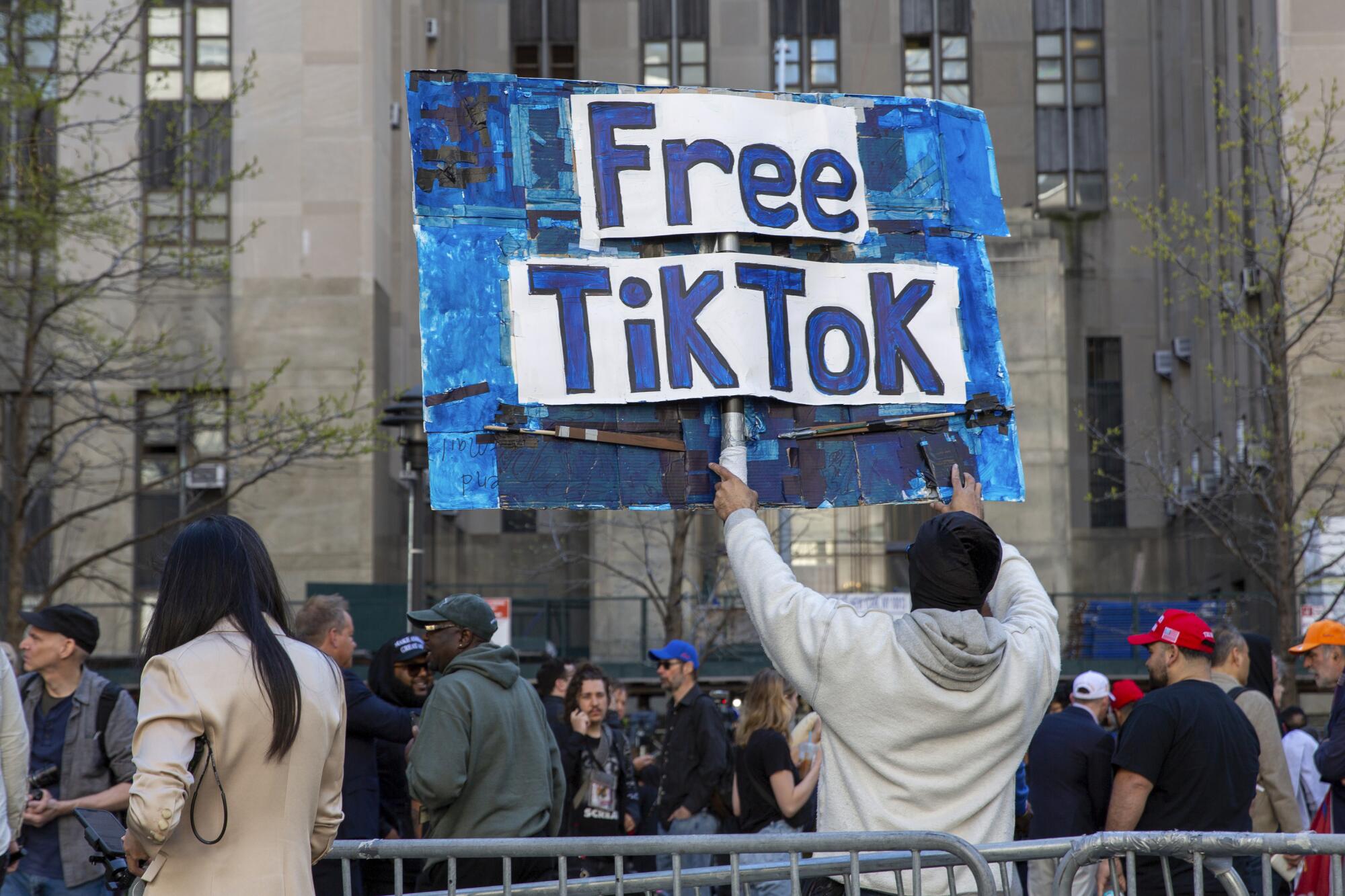
A man demonstrates outside the courthouse in New York where the hush money trial of Donald Trump got underway on April 15, 2024.
(Ted Shaffrey / Associated Press)
“I don’t think the average TikTok user has synthesized in their brain that this is going away,” said Lawrence Vincent, associate professor of the practice of marketing at USC’s Marshall School of Business. “They’ve heard about it, but it isn’t real until it’s real.”
There has been little anticipatory migration to other platforms. But former TikTokers in India advised their American counterparts to prepare for the worst.
“We used to hear rumors about this happening, but we never really believed it,” said Ashi Khanna, a 26-year-old influencer from Delhi.
She launched her TikTok career by posting lip-synching videos in 2017 — when the app was known as Music.ly — and eventually built a following of 1.7 million. She managed to post a farewell directing them to Instagram and YouTube, where she already had smaller followings. But fewer than 20,000 did so.
Since then, Khanna has concentrated on Instagram and managed to match her old following.
In contrast to TikTok, which never placed a premium on production quality, Instragram required a more polished aesthetic that could mean spending hours on a single reel.
“There’s a huge difference,” Khanna said. “You need to understand what your audience likes, and your audience is not the same on every platform.”
Ankita Chhetri, 22, who lives in Mumbai, said experimentation was the key to life beyond TikTok.
She became TikTok famous in 2019 after posting a video of herself lip-synching to a popular Bollywood song. With 8.2 million followers, she earned promotional deals with music labels and scrapped her plans to be a nurse in hopes of making it as an influencer and actor.
After the ban, she started a YouTube channel and branched out from lip-synching into carefully planned reels of beauty, travel, fashion and inspirational quotes. As she gradually increased her following to 1.6 million, she used her improved engagement statistics to pitch brands on potential partnerships.
Still, Chhetri said there are times she misses the old days.
“TikTok just had some crazy amount of loyalty among audiences,” she said. “On Instagram, even if people are watching and liking your content, they’re still hesitant to press that follow button.”
Indian entrepreneurs created their own versions of TikTok, but failed to get much of an audience.
“It still felt like I was invisible, nobody was really there,” said Shreyas Mendiratta, a 23-year-old hospital worker who posted his comedy videos on Indian startup apps for a few months before giving up. “On TikTok, I felt seen, I felt heard.”

Geet Jain records herself for social media.
(Courtesy of Geet Jain)
His videos don’t do as well on Instagram and YouTube either, which he suggested lack TikTok’s broad international appeal.
“It reduces the chances of them going global,” he said. “This is what I face on Instagram daily. I am very restricted to the region that I am geographically located in.”
Geet Jain, an inspirational speaker and English teacher, was visiting the U.S. when India banned TikTok. She could still use the app, but none of her 7 million followers in India could see her posts offering relationship advice, comedy bits and English lessons.
“It was like this whirlwind of confusion of what do I do next,” said Jain, who declined to provide her age.
She turned to Instagram, growing 68,000 followers into 1.3 million. But she never achieved the same kind of exponential growth. Some of her TikTok fans had a difficult time finding her.
Back in the U.S. this year for an extended stay with her sister in Seattle, she has started posting on TikTok once more.
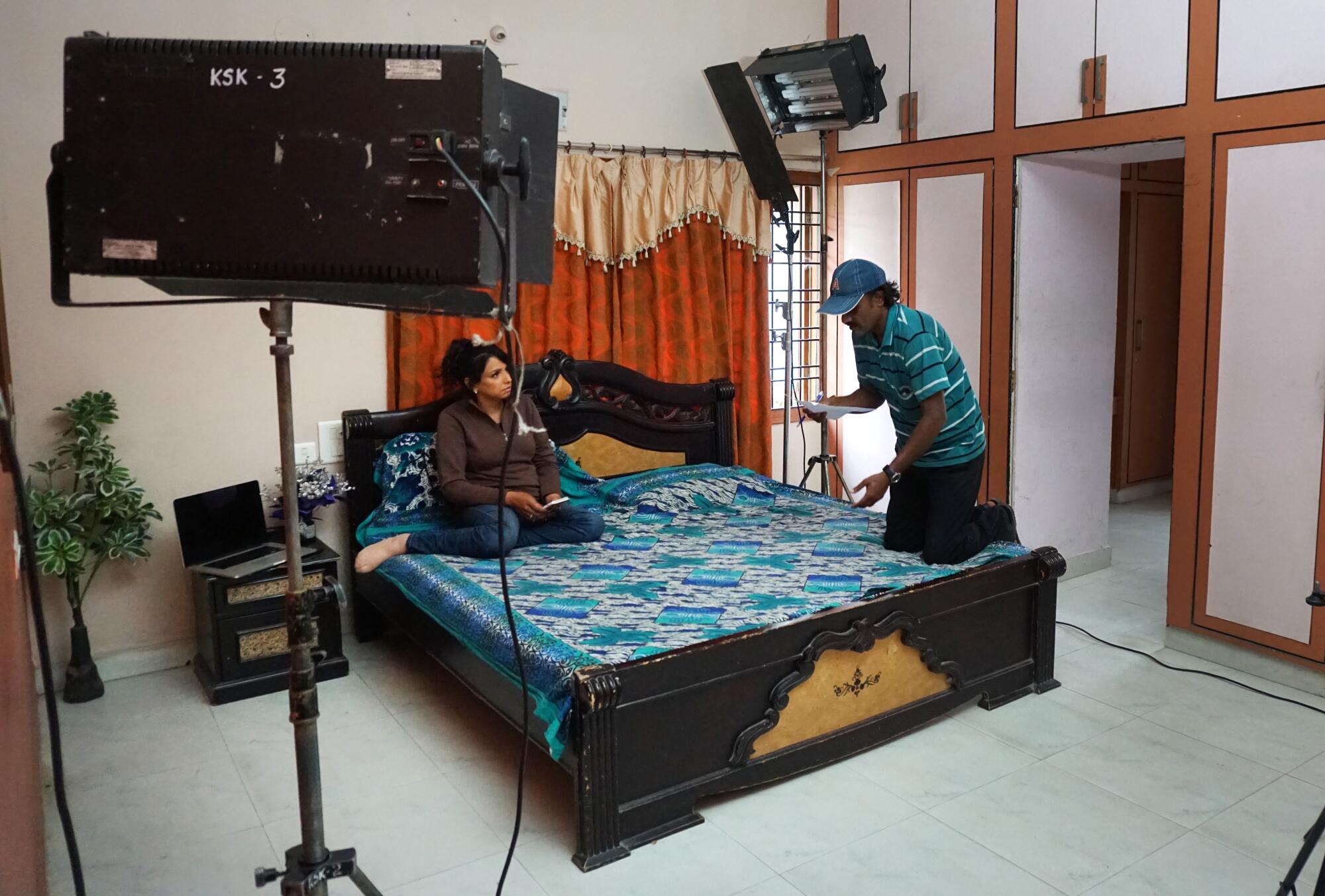
Geet Jain, an inspirational speaker and English teacher in India, was in the U.S. when India banned TikTok in June 2020.
Back in the U.S. this year for an extended stay in Seattle, she has started posting on TikTok once more.
(Courtesy of Geet Jain)
But she no longer knows what viewers want. Clips have gotten longer, with more casually narrated stories and less dancing and lip-synching than she remembers. There is more competition when it comes to her style of educational content.
While some of her English-language videos have gotten traction, she’s reluctant to invest too heavily in TikTok again.
“If it gets banned in America, it will be even more devastating for me,” she said. “Then my accounts are actually gone.”

Entertainment
Emma Myers leads a suspenseful teen mystery in 'A Good Girl's Guide to Murder'

As someone who grew up reading the Hardy Boys, collecting a long shelf of those beautiful blue spines, I am all about the teenage detective. Nancy Drew, “Scooby-Doo,” Shelby Woo, Hayley Mills in “The Moon-Spinners.” As for the teens and tweens such stories nominally target, that is a population into whose lives every day brings some new mystery — mysteries of the heart, mysteries of the changing body, mysteries of the weird parents, mysteries of the missing friends with apparently new friends. These stories can be empowering, like spiritual krav maga.
Adapted by Poppy Cogan from British writer Holly Jackson’s popular 2019 YA novel, “The Good Girl’s Guide to Murder,” premiering Thursday on Netflix, is an involving ride — not so much for the plot as for the characters (which is how all detective stories live or die) and a great performance by Emma Myers (“Wednesday”) as its central sleuth, Pippa Fitz-Amobi. It’s less whimsical than the title might lead one to expect, but short on grit and long on feeling.
We are in Little Kilton, a picturesque English village, the sort of place where, sayeth Miss Marple, “you turn over a stone and have no idea what will crawl out” — and Miss Marple is rarely wrong. Five years earlier, the town was roiled by the disappearance of teenager Andie Bell (India Lillie Davies) and the confession and apparent suicide of her boyfriend, Sal Singh (Rahul Pattni). Though the villagers seem intent on leaving the past in the past, there is also a big mural honoring her and what looks like a steady stream of flowers and mementos marking the shrine. So that book is not entirely closed.
Pippa or Pip, now a senior herself, remembers seeing Andie and Sal on the day of her disappearance, and also that Sal was always nice to her; she doesn’t think he’s someone who could kill anyone, and for her senior project, or under cover of same, has decided to investigate the case.
Ravi (Zain Iqbal) steps in to help Pip (Emma Myers) solve the mystery of Andie and his brother, Sal.
(Sally Mais/Netflix)
This connects her with Ravi (Zain Iqbal), Sal’s younger brother, who, like everyone but Pip, accepts the accepted verdict; at least, he has put it behind him, until Pip gets him interested, and together they turn sleuth — he calls her “Sarge,” as in detective sergeant, and they spar over who’s Holmes and who’s Watson, or more specifically, who’s Cumberbatch and who’s Freeman. But it’s clearly Pip leading the way.
Pip turns her bedroom wall into a murder board, pasted with clippings and photographs and various notes to self. (It takes her mother a while to notice this.) Across six 40-minute episodes, she moves about the town, from garden party to rave to locker room, as her “project” morphs from schoolwork to amateur police work. Threatening notes and texts arrive warning her to “stop digging.” But she has also has reason to question her own motives.
“I’m just trying to find out the truth,” Pip tells Andie’s lookalike sister Becca (Carla Woodcock).
“It’s not about the truth,” Becca replies. “People act like this stuff is for the dead person, but it’s not, it’s for them.”
As the title indicates, Pip’s a good girl, who doesn’t exactly go bad, but she will lie to her parents (Anna Maxwell Martin and Gary Beadle), ignore their orders, do shots in exchange for information and commit a fair amount of breaking and entering — entering, anyway — in order to find clues and steal evidence. Which, frankly, is good training to be a detective in crime fiction.
It’s a big cast, replete with siblings, friends, townfolk and parents, including Mathew Baynton of “The Wrong Mans” and the U.K. version of “Ghosts,” as Pip’s teacher and the father of her friend Cara (Asha Banks). But above all, it’s Myers’ show. (The actor is American, reversing the more common situation of Britons playing Yanks, but, really, I had no idea.) Small and slight, with big, expressive, wide-set eyes, a forehead made for writing thoughts upon and the mouth of a silent movie star; at 22, she makes an entirely credible 17-year-old — scared and excited, sure of herself even as she’s unsure of herself. Myers is especially fine conveying a sort of shyness seasoned with bravado, along with various degrees of worry that only increase as she blusters her way into ever more perilous situations.
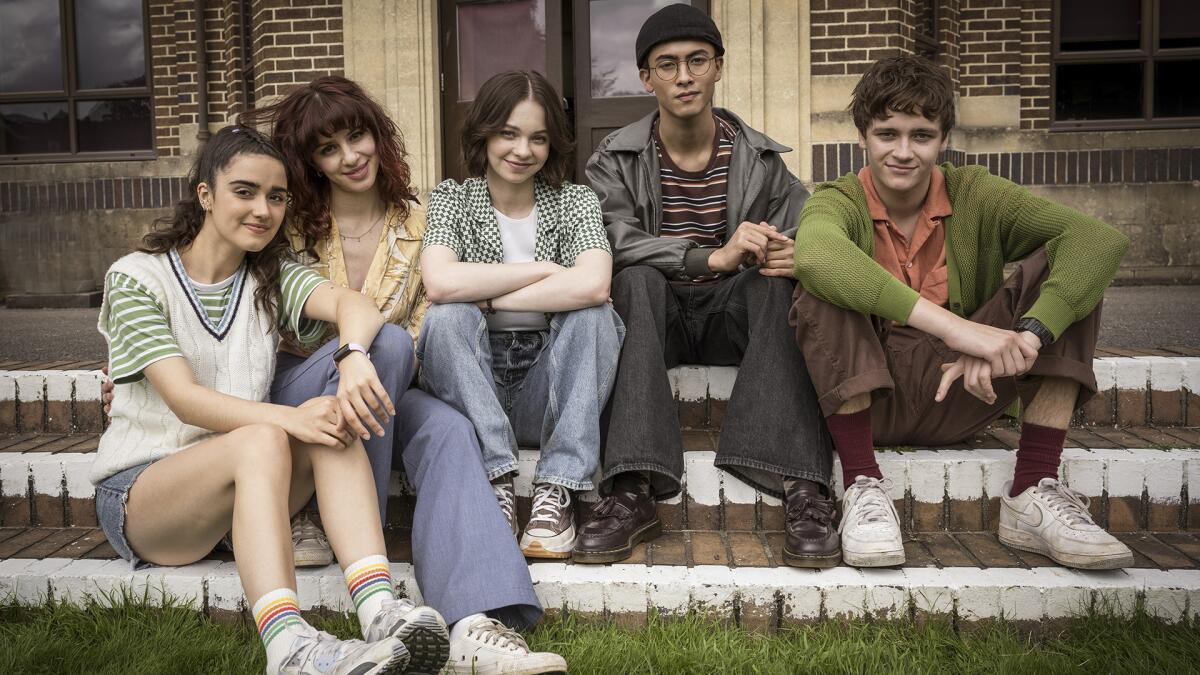
The cast of Netflix’s “A Good Girl’s Guide to Murder,” from left: Asha Banks as Cara Ward, Yali Topol Margalith as Lauren Gibson, Emma Myers as Pip Fitz-Amobi, Raiko Gohara as Zach Chen, and Jude Morgan-Collie as Connor Reynolds.
(Sally Mais/Netflix)
The direction, by Dolly Wells and Tom Vaughan, is admirably straightforward; the show is suspenseful because it’s full of suspenseful situations, not for being overloaded with dark music, disturbing sound effects and shocking camera moves. As is true of the best British mysteries, we’re in a real place among plausible people. There’s no attempt to make the teenage characters glamorous or sexy or overly adult — a couple of the older-generation youngsters fancy themselves to be so, but they’re fairly transparent. Pip’s friends trend nerdy and late-blooming, which should make them relatable to a large segment of the show’s young, and for that matter, formerly young, audience. (I’d advance them as role models, as well, but that is perhaps wishful thinking.) They may be pushed out of their comfort zone by circumstances, but they are not pushed out of it by the writers, if you see what I mean.
Not everything Pip does when faced with trouble makes much sense, but in this she has plenty of adult detective company. You can often find me yelling through the screen at gumshoes who, alone with a killer, announce that they know what they did and how they did and therefore must wriggle out of danger one more time. It goes with the territory.
As to the endgame — no spoilers here — the details are not predictable in themselves, but, to put it in musical terms, there’s a sort of half cadence followed by an authentic cadence followed by a plagal cadence. You will have guessed some of it from the first episode, if you have any experience with mysteries, or even movies, though you could not possibly see the rest coming, because essential information is held back until late and guilty parties in TV mysteries are extraordinary good at seeming innocent. They tend not to play fair, and “Good Girl’s Guide” is no exception.
I probably should have mentioned, though it should be obvious from the above, that this is also a coming-of-age story, centered on a partnership that becomes a friendship that might one day turn into something more — and which, like every screen romance ever, will run into trouble about two-thirds of the way through.
I can say no more.
Movie Reviews
Book Review: Captured by Love

Book Review: Captured by Love
By Jason Hooker
Captured by Love is a non-fiction book combining multiple accounts about the real love stories that developed in the lives of the Vietnam War POW’s and their wives back home. It is co-authored by Lee Ellis (a former POW) and Greg Godek (relationship and romance author), who have done a remarkable job of shining light, hope and beauty into the horrific experiences of the POW’s. This positive outlook threads the writing style of every account, each of which is made from interviews and writing from the real people behind the stories. It truly is wonderful to read these true stories of beauty arising from the least likely of contexts.
At the end of every account, the book takes a moment to pause and reflect on the values we can apply to our romantic relationships, as inspired by the real-life goodness lived out in the lives of the POW’s and their wives. Many of them were men and women of faith and testify to the powerful role their faith played in giving them endurance and hope. We are also intermittently given small insights into the factual history surrounding each story, so that we are grounded in knowledge but not so distracted by facts that it feels like a history book. Every account feels personable and emotionally evocative.
This book is incredibly inspiring and heart-warming to read. It is an amazing experience to read about the perseverance, devotion and bravery that the POW’s and their wives upheld during times of trial, and it is a wonderful testament to the power of faith. For anyone interested in inspiring true stories, the beauty of romantic relationships, or world history, this book is a wonderful blend of elements that will inspire and uplift you.
The authors dedicate the book to “couples everywhere that aspire to keep the love-of-their-life, soulmate-relationship vibrant and growing for a lifetime”.
Entertainment
Price finally revealed for Disney, Warner and Fox sports streaming service Venu
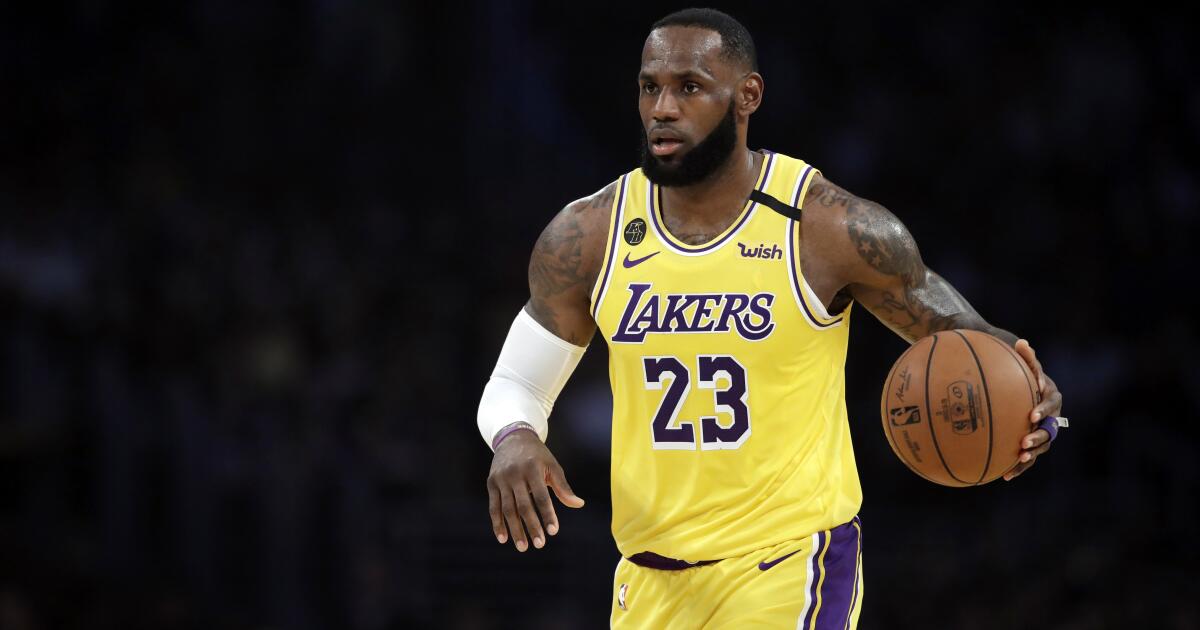
Venu Sports, the new joint streaming venture from Walt Disney Co., Warner Bros. Discovery and Fox Corp., has finally revealed what it will charge subscribers.
$42.99 a month.
The service will have a seven-day free trial, the joint venture said Thursday.
Scheduled to launch in the fall, the offering will give fans access to games from the NFL, NHL, NBA, MLB and other sports the three partners carry on their linear TV channels.
The aim of the platform, announced in February, is to provide a destination that will appeal to younger sports fans who are bypassing traditional pay-TV subscriptions.
Fox Corp. Chairman Lachlan Murdoch has said the potential customer pool is the 60 million U.S. households not connected to cable or satellite TV.
The trio of traditional media companies have joined forces to compete with deep-pocketed tech companies that are spending heavily to offer live sports on their streaming services.
Netflix recently announced it had acquired the rights to two NFL Christmas games in 2024, and at least one during the next two seasons. Amazon’s Prime Video just landed a significant package of NBA games in the league’s next media rights deal.
Pete Distad is chief executive of Venu Sports. He previously worked at Apple and Hulu.
-

 Mississippi2 days ago
Mississippi2 days agoMSU, Mississippi Academy of Sciences host summer symposium, USDA’s Tucker honored with Presidential Award
-

 News1 week ago
News1 week agoHow the Trump Rally Gunman Had an Edge Over the Countersnipers
-

 World1 week ago
World1 week agoTyphoon Gaemi barrels towards China’s Fujian after sinking ship off Taiwan
-
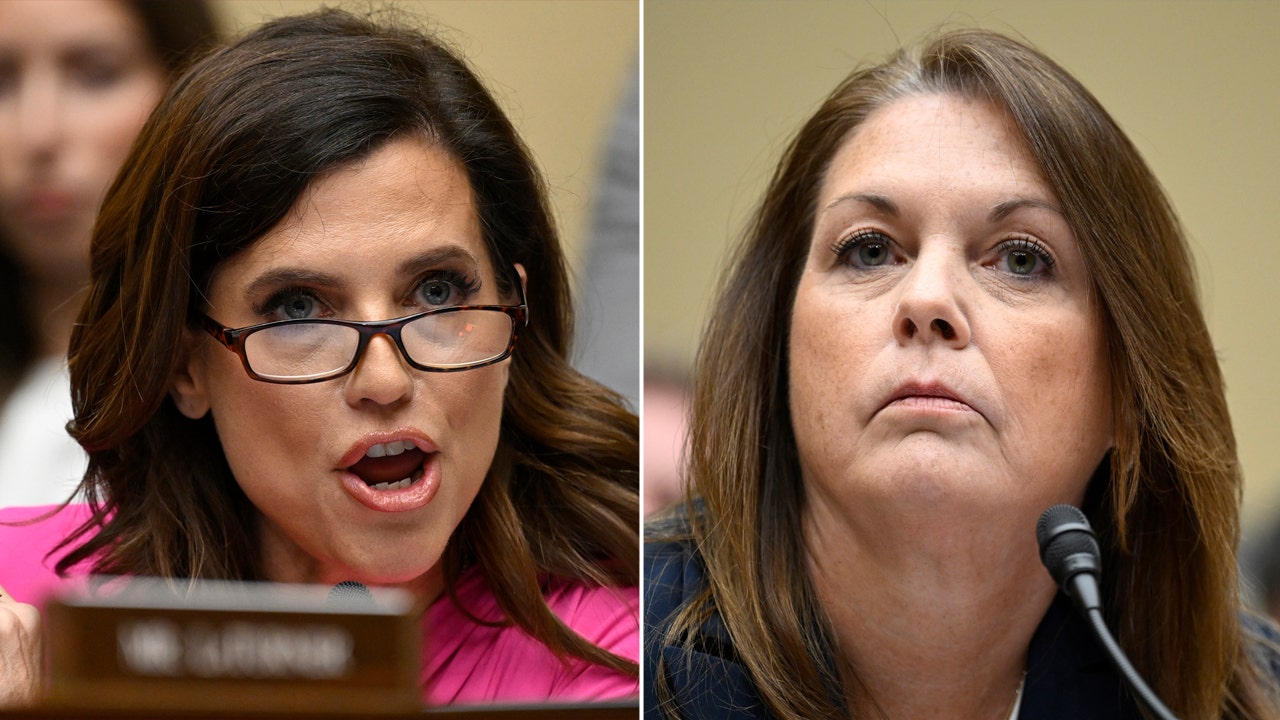
 Politics1 week ago
Politics1 week agoTop five moments from Secret Service director's hours-long grilling after Trump assassination attempt
-

 World1 week ago
World1 week agoViolence against women, girls at ‘epidemic’ levels: UK police
-

 News1 week ago
News1 week agoGeorge Clooney Endorses Kamala Harris, Says Biden Is ‘Saving Democracy’
-

 News1 week ago
News1 week agoVideo: Secret Service Director Faces Bipartisan Calls to Resign
-

 News1 week ago
News1 week agoA coup, fake signatures and deepfakes are the latest conspiracy theories about 2024

